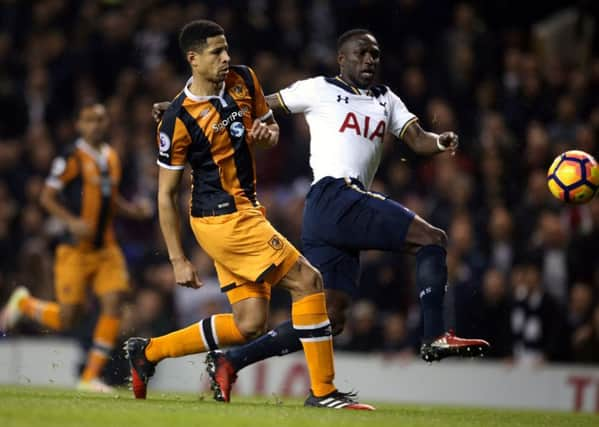New venues can bring atmospheric pressures


All, of course, are perfectly good gauges of the tidal wave of popularity that the Premier League continues to ride.
But perhaps the biggest indicator of all is how dramatically the football skyline has changed and continues to do so.
Advertisement
Hide AdAdvertisement
Hide AdThe building work on Tottenham Hotspur’s new £750m stadium that continued even during Wednesday night’s 3-0 defeat for Hull City is just the latest instance of a top-flight club flexing its financial muscles to make a fresh start in state-of-the surrounds.
No fewer than seven of the current 20 elite clubs have moved home since the turn of the Millennium.
Delve a little further back and that number is swelled further by Sunderland, Stoke City and Middlesbrough.
The flipside of this exciting new dawn is that traditional football cathedrals have been disappearing at a fast rate. Highbury is perhaps the most mourned, the sight of Arsenal’s old home, now converted into flats, viewed from the train window en route into King’s Cross is still enough to elicit a nostalgic sigh from this correspondent.
Advertisement
Hide AdAdvertisement
Hide AdBut Maine Road, Roker Park et al had their own unique features that are much missed by football fans who used to make annual pilgrimages with their team.
Upton Park was the latest to go last summer and White Hart Lane will follow in May. Stamford Bridge’s days are also numbered and Hull defender Curtis Davies, who will follow probably his last appearance at Spurs’ current home with a first visit to West Ham’s London Stadium, laments the demise of these old, famous grounds.
“White Hart Lane has always been one of my favourite grounds to play,” the 31-year-old defender told The Yorkshire Post. “It has always been local to where my family are from.
“Apart from West Ham’s new stadium, Tottenham are the closest to my home so I usually have quite a few family there. I have also scored there in the past and I always enjoyed playing at White Hart Lane.
Advertisement
Hide AdAdvertisement
Hide Ad“The atmosphere is usually good, too. So, it will be interesting to see if they can keep that when the new stadium is opened.
“I saw Arsene Wenger say something along those lines recently, about how it takes time to settle into a new stadium and create an atmosphere. Arsenal took a while to adjust to the Emirates.
“Highbury was a tight little ground, the fans close to the pitch. When they moved to the Emirates, suddenly everyone was an away fan. If Spurs can get to grips with the new stadium and surroundings quickly, they will be okay.
“But it doesn’t always happen like that. Wembley was a bit of a problem for them (in the Champions League), even though Spurs are a good football team.”
Advertisement
Hide AdAdvertisement
Hide AdFor now, Mauricio Pochettino’s side are making a good fist of signing off with style from the club’s home for 118 years before decamping to the national stadium for 12 months as White Hart Lane is flattened to make way for the final stage of the club’s new home.
Spurs have lost just once in the league at home in 2016 and the 3-0 win over Hull followed a five-goal dismantling of Swansea City in their previous home fixture.
West Ham, Hull’s opponents for their second visit to the capital inside 65 or so hours, also claimed maximum points on Wednesday night as Burnley were beaten by Mark Noble’s goal.
It was, though, only a third triumph for Slaven Bilic’s men in eight games at their new home and the first in almost two months.
Advertisement
Hide AdAdvertisement
Hide AdThe Hammers have suffered serious teething trouble at a venue that was built for the 2012 Olympic Games.
After so long at the atmospheric Upton Park, supporters have found the switch difficult. Several outbreaks of hooliganism have understandably caught the headlines, but fan discontent with the London Stadium is as much down to its unsuitability as a football ground.
Some fans behind the goals are an eye-straining distance from the pitch, while the front few rows of retractable seats offer little perspective of the action. Rows have also broken out between fans used to standing up at home games last season and those who want to sit.
Hull will tomorrow aim to exploit the unease felt by the far from happy Hammers as Mike Phelan’s men look to end a six-game losing streak on the road.
Advertisement
Hide AdAdvertisement
Hide Ad“West Ham were caught in a bad time,” added Leytonstone-born Davies. ”They moved to the new stadium, but also lost most of their strikers to injury.
“The £20m signing (Andre) Ayiew was out and that was bad timing. It meant they were struggling for goals, just as they moved into new surroundings. Results suffered. Now, though, a few are back and it was a great result (a draw) at Liverpool. With games against Burnley and then us, they will see this as a week to pick up points, but we have to stop them.”